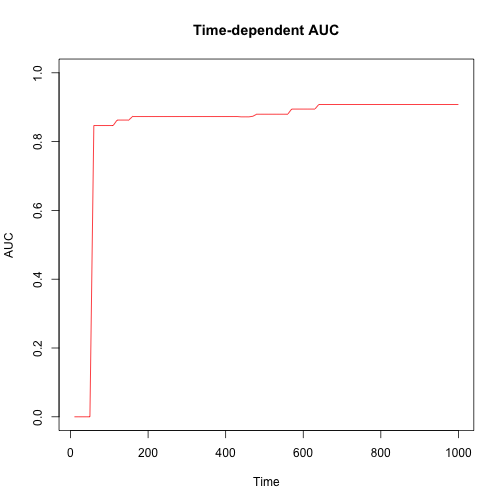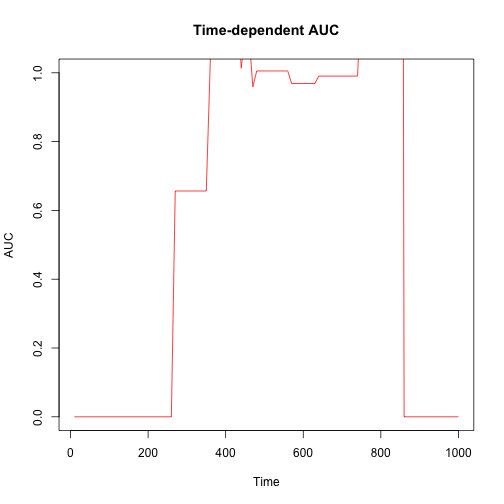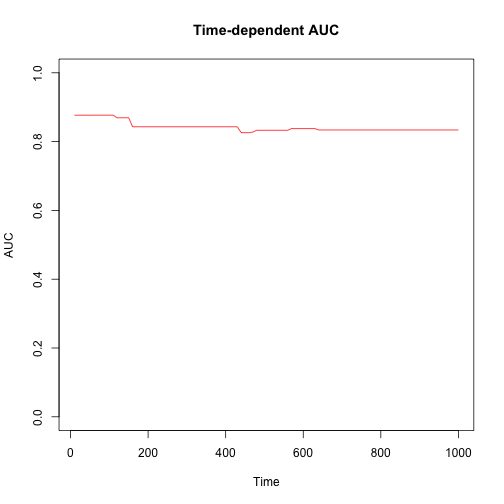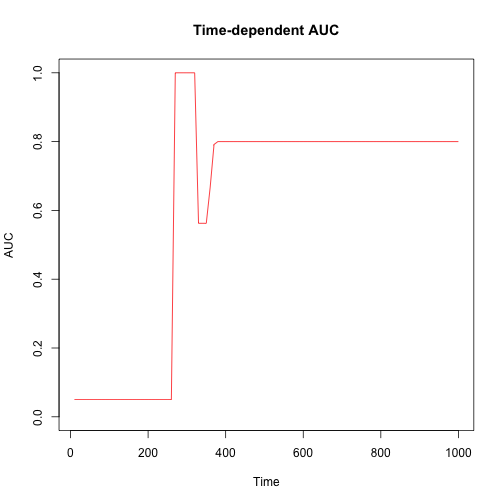

https://doi.org/10.32614/CRAN.package.survAUC
The goal of survAUC is to provide a variety of functions to estimate time-dependent true/false positive rates and AUC curves from a set of censored survival data.
You can install the released version of survAUC from CRAN with:
install.packages("survAUC")And the development version from GitHub with:
install.packages("devtools")
devtools::install_github("fbertran/survAUC")or alternatively
# install.packages("pak")
pak::pak("fbertran/survAUC")This is a basic example which shows you how to solve a common problem:
library(survAUC)Retrieve the example dataset, split it into a train (TR)
and a test (TE) set. Then train a model on the train set
and derive predictions for both train (lp and
Surv.rsp) and test (lpnew and
Surv.rsp.new).
data(cancer,package="survival")
TR <- ovarian[1:16,]
TE <- ovarian[17:26,]
train.fit <- survival::coxph(survival::Surv(futime, fustat) ~ age,
x=TRUE, y=TRUE, method="breslow", data=TR)
lp <- predict(train.fit)
lpnew <- predict(train.fit, newdata=TE)
Surv.rsp <- survival::Surv(TR$futime, TR$fustat)
Surv.rsp.new <- survival::Surv(TE$futime, TE$fustat)
times <- seq(10, 1000, 10) This function implements the estimator of cumulative/dynamic AUC
proposed in Section 3.3 of Chambless and Diao (2006). In contrast to the
general form of Chambless and Diao’s estimator, AUC.cd is
restricted to Cox regression.
Specifically, it is assumed that lp and
lpnew are the predictors of a Cox proportional hazards
model. Estimates obtained from AUC.cd are valid as long as
the Cox model is specified correctly.
The iauc summary measure is given by the integral of AUC
on \([0,max(\textrm{times})]\)
(weighted by the estimated probability density of the time-to-event
outcome).
AUC_CD <- AUC.cd(Surv.rsp, Surv.rsp.new, lp, lpnew, times)
AUC_CD$iauc
#> [1] 0.8728364AUC_CD
#> $auc
#> [1] 0.0000000 0.0000000 0.0000000 0.0000000 0.0000000 0.8467091
#> [7] 0.8467091 0.8467091 0.8467091 0.8467091 0.8467091 0.8625872
#> [13] 0.8625872 0.8625872 0.8625872 0.8728364 0.8728364 0.8728364
#> [19] 0.8728364 0.8728364 0.8728364 0.8728364 0.8728364 0.8728364
#> [25] 0.8728364 0.8728364 0.8728364 0.8728364 0.8728364 0.8728364
#> [31] 0.8728364 0.8728364 0.8728364 0.8728364 0.8728364 0.8728364
#> [37] 0.8728364 0.8728364 0.8728364 0.8728364 0.8728364 0.8728364
#> [43] 0.8728364 0.8719455 0.8719455 0.8719455 0.8736755 0.8795809
#> [49] 0.8795809 0.8795809 0.8795809 0.8795809 0.8795809 0.8795809
#> [55] 0.8795809 0.8795809 0.8945198 0.8945198 0.8945198 0.8945198
#> [61] 0.8945198 0.8945198 0.8945198 0.9078402 0.9078402 0.9078402
#> [67] 0.9078402 0.9078402 0.9078402 0.9078402 0.9078402 0.9078402
#> [73] 0.9078402 0.9078402 0.9078402 0.9078402 0.9078402 0.9078402
#> [79] 0.9078402 0.9078402 0.9078402 0.9078402 0.9078402 0.9078402
#> [85] 0.9078402 0.9078402 0.9078402 0.9078402 0.9078402 0.9078402
#> [91] 0.9078402 0.9078402 0.9078402 0.9078402 0.9078402 0.9078402
#> [97] 0.9078402 0.9078402 0.9078402 0.9078402
#>
#> $times
#> [1] 10 20 30 40 50 60 70 80 90 100 110 120
#> [13] 130 140 150 160 170 180 190 200 210 220 230 240
#> [25] 250 260 270 280 290 300 310 320 330 340 350 360
#> [37] 370 380 390 400 410 420 430 440 450 460 470 480
#> [49] 490 500 510 520 530 540 550 560 570 580 590 600
#> [61] 610 620 630 640 650 660 670 680 690 700 710 720
#> [73] 730 740 750 760 770 780 790 800 810 820 830 840
#> [85] 850 860 870 880 890 900 910 920 930 940 950 960
#> [97] 970 980 990 1000
#>
#> $iauc
#> [1] 0.8728364
#>
#> attr(,"class")
#> [1] "survAUC"plot(AUC_CD)
plot of chunk unnamed-chunk-8
This function implements the estimator of cumulative/dynamic AUC proposed by Hung and Chiang (2010).
The estimator is based on inverse-probability-of-censoring weights
and does not assume a specific working model for deriving the predictor
lpnew. It is assumed, however, that there is a one-to-one
relationship between the predictor and the expected survival times
conditional on the predictor.
The iauc summary measure is given by the integral of AUC
on \([0, max(\textrm{times})]\)
(weighted by the estimated probability density of the time-to-event
outcome).
AUC_hc <- AUC.hc(Surv.rsp, Surv.rsp.new, lpnew, times)
AUC_hc$iAUC
#> NULLplot(AUC_hc)
plot of chunk unnamed-chunk-10
The sens.sh and spec.sh functions implement
the estimators of time-dependent true and false positive rates proposed
by Song and Zhou (2008).
The AUC.sh function implements the estimators of
cumulative/dynamic and incident/dynamic AUC proposed by Song and Zhou
(2008). These estimators are given by the areas under the time-dependent
ROC curves estimated by sens.sh and
spec.sh.
In case of cumulative/dynamic AUC, the iauc summary
measure is given by the integral of AUC on \([0,max(\textrm{times})]\) (weighted by the
estimated probability density of the time-to-event outcome).
In case of incident/dynamic AUC, iauc is given by the
integral of AUC on \([0,
max(\textrm{times})]\) (weighted by 2 times the product of the
estimated probability density and the estimated survival function of the
time-to-event outcome).
lp <- predict(train.fit)
AUC_sh <- AUC.sh(Surv.rsp, Surv.rsp.new, lp, lpnew, times)
names(AUC_sh)
#> [1] "auc" "times" "iauc"
AUC_sh$iauc
#> [1] 0.8430845plot(AUC_sh)
plot of chunk unnamed-chunk-12
The sens.uno and spec.uno functions
implement the estimators of time-dependent true and false positive rates
proposed in Section 5.1 of Uno et al. (2007).
The AUC.uno function implements the estimator of
cumulative/dynamic AUC that is based on the TPR and FPR estimators
proposed by Uno et al. (2007).
It is given by the area(s) under the time-dependent ROC curve(s)
estimated by sens.uno and spec.uno. The
iauc summary measure is given by the integral of AUC on
\([0, max(\textrm{times})]\) (weighted
by the estimated probability density of the time-to-event outcome).
AUC_Uno <- AUC.uno(Surv.rsp, Surv.rsp.new, lpnew, times)
names(AUC_Uno)
#> [1] "auc" "times" "iauc"
AUC_Uno$iauc
#> [1] 0.7552083plot(AUC_Uno)
plot of chunk unnamed-chunk-14
The UnoC function implements the censoring-adjusted
C-statistic proposed by Uno et al. (2011). It has the same
interpretation as Harrell’s C for survival data (implemented in the
rcorr.cens function of the Hmisc package).
Cstat <- UnoC(Surv.rsp, Surv.rsp.new, lpnew)
Cstat
#> [1] 0.7333333Chambless, L. E. and G. Diao (2006). Estimation of time-dependent area under the ROC curve for long-term risk prediction. Statistics in Medicine, 25, 3474-3486.
Hung, H. and C.-T. Chiang (2010). Estimation methods for time-dependent AUC models with survival data. Canadian Journal of Statistics, 38, 8-26.
Song, X. and X.-H. Zhou (2008). A semiparametric approach for the covariate specific ROC curve with survival outcome. Statistica Sinica, 18, 947-965.
Uno, H., T. Cai, L. Tian, and L. J. Wei (2007). Evaluating prediction rules for t-year survivors with censored regression models. Journal of the American Statistical Association, 102, 527-537.